目录:

1、权限的管理 1-1、什么是权限管理 1-2、什么是身份认证 1-3、什么是授权 2、什么是shiro 3、shiro的架构 4、shiro中的认证 4-1、认证的认识 4-2、关键对象 4-3、认证的流程 4-4、代码测试 4-5、自定义Realm 4-5-1、为什么自定义Realm 4-5-2、Realm类结构图 4-6、认证时加入MD5和盐(salt) 5、授权 5-1、授权的认识 5-2、关键对象 5-3、授权的流程 5-4、授权的方式 5-5、权限字符串 5-6、shiro中检查授权是否拥有的实现方式 5-7、代码测试 6、SpringBoot整合Shiro 6-1、创建SpringBoot项目 6-2、导入依赖 6-3、配置环境 6-4、创建需要的文件和资源 6-5、资源权限约定 6-6、配置认证控制测试效果 6-7、shiro中常见过滤器 6-8、认证的实现 6-9、退出认证 6-10、认证时加入MD5和盐 6-11、授权实现 6-11-1、页面资源方式权限控制 6-11-2、代码方式权限控制 6-11-3、方法调用方式权限控制 6-11-4、测试权限控制 6-11-5、结合数据库表来测试授权实现 6-12、使用CacheManager 6-12-1、作用 6-12-2、Shiro默认的本地缓存EhCache 6-12-2-1、引入依赖 6-12-2-2、开启缓存 6-12-2-3、测试 6-12-3、使用Redis作为缓存实现 6-12-3-1、引入依赖 6-12-3-2、配置Redis相关 6-12-3-3、自定义缓存管理器(CacheManager)和缓存实现(Cache) 6-12-3-4、如遇见SimpleByteSource未序列化错误请看这里 6-12-3-5、测试 6-12-4、图片验证码(可选) 7、Thymeleaf中使用Shiro标签 7-1、引入依赖 7-2、配置方言 7-3、页面引入命名空间和常用标签
注意:本文仅仅是笔记。
1 权限的管理
1-1 什么是权限管理
权限管理说白了就是,约束系统资源能被谁访问,不能被谁访问。现在基本上涉及到用户参数的系统都需要进行权限的约束和管理。权限管理实现的目的就是对用户访问资源的控制,用户只能访问已经被授权的资源。
权限管理大致非为身份认证和授权两个点,对于绝大多数资源需要用户经过了身份认证,而对于需要权限控制的资源,则需要用户被授予指定权限,简称授权。
1-2 什么是身份认证
原意是判断一个用户是否为合法用户的处理过程,简单地讲就是登录,需要确定你有账号,账号正常,那么才能进入系统,这就是身份认证,当然登录并不是唯一的认证方式,也有很多其他的认证方式,例如指纹认证、刷卡、人脸等。
1-3 什么是授权
授权就是给予已经认证的用户访问某些资源的权限的过程,用户必须认证后才能进行授权,用户只能访问被授访问权限的资源,没有被授予权限的资源是无法访问的。
2 什么是shiro
官方是这样说的:
Apache Shiro™ is a powerful and easy-to-use Java security framework that performs authentication,
authorization, cryptography, and session management. With Shiro’s easy-to-understand API, you can
quickly and easily secure any application – from the smallest mobile applications to the largest web and enterprise applications.
翻译后就是:
Apache Shiro™是一个功能强大、易于使用的java安全框架,它执行身份验证, 授权、密码学和会话管理。 使用Shiro的易于理解的API,您可以 快速和容易地安全任何应用程序-从最小的移动应用程序到最大的Web和企业应用程序。
白话文就是:
shiro很强大、简单,它的功能有进行身份认证、授权、加密、会话管理灯,shiro的易于理解的API可以让您快速且容易的和任何应用程序集成,
其实还有一种权限框架,是SpringSecurity,它的功能比Shiro更加的强大,但是SpringSecurity的学习难度更大,花费时间更久,所以两者各有千秋,具体选择看工作中公司要求。
3 shiro的架构
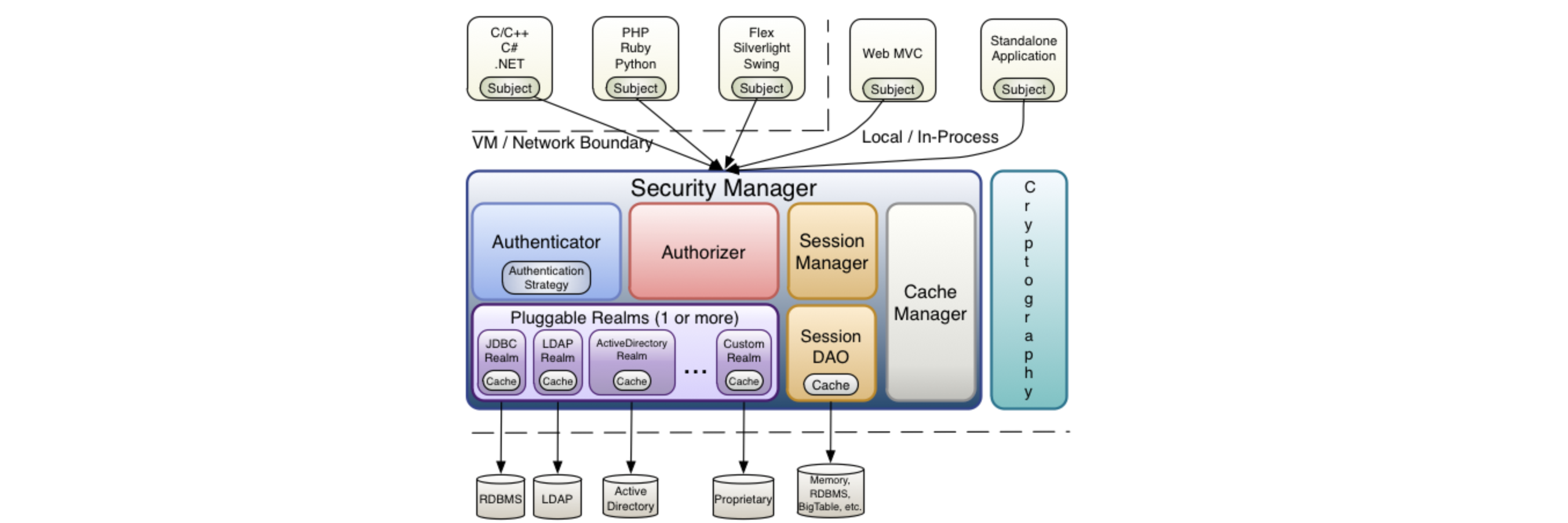
上面的就是不同的语言,例如c/c++/.net/php等,他们都可以是主体,然后来进行认证授权等操作。中间左边是核心组件,例如认证、授权、会话管理、缓存管理、realm、会话dao等。
我们来详细的每个都看看是什么意思:
Subject:
主体,subject代表着当前的用户,概念理解为当前操作的主体,以后也都是叫主体。
Subject是一个接口,定义了很多认证授权相关的方法。
SecurityManager:
安全管理器,SecurityManager对所有的Subject进行安全管理。
Authenticator:
认证器,即对用户身份进行认证。
Authorizer:
授权器,用户通过认证后,访问其他受限资源的时候,需要通过授权器判断该用户是否具有访问此功能的权限。
Realm:
领域,可以看成数据源,SecurityManager进行认证和授权的时候,需要获取用户或用户权限数据,这个Realm就是来完成认证、授权数据的获取的。
SessionManager:
会话管理,shiro自己定义了一套会话管理,它不依赖于我们servlet的session,所以shiro可以用在非web应用上,也可以将会话统一集中在一个点来管理,所以shiro也可以实现单点登录。
SessionDAO:
会话DAO,是对会话操作的一套接口。
CacheManager:
缓存管理,比如将用户权限数据存储在缓存中,这样可以提交性能。
Cryptography:
密码管理,提供了一套加密/解密的组件,方便开发,比如散列,md5这种。
4 shiro中的认证
4-1 认证的认识
身份认证,就是判断一个用户是为合法用户的处理过程。最常用的简单身份认证方式是通过核对用户名和密码,看是否与数据库中存储的该用户的用户名和口令一致,用这种方式来判断用户身份是否正确。
4-2 关键对象
- Subject:主体
- 访问系统的用户,也就是主体。
- Principal:身份信息
- 主体进行身份认证的标识,该标识必须唯一。一个主体可以有多个身份信息,但必须有一个主身份(Primary Principal),这个主身份唯一且不能重复。
- 多个身份标识比如,用户名,手机号,邮箱地址,这些都是主体的身份标识,但用户名就可以作为主身份,因为它唯一且不重复。
- Credential:凭证信息
- 说白了就是只有主体自己知道的安全信息,别人不知道的,比如说私钥,密码等。
4-3 认证的流程
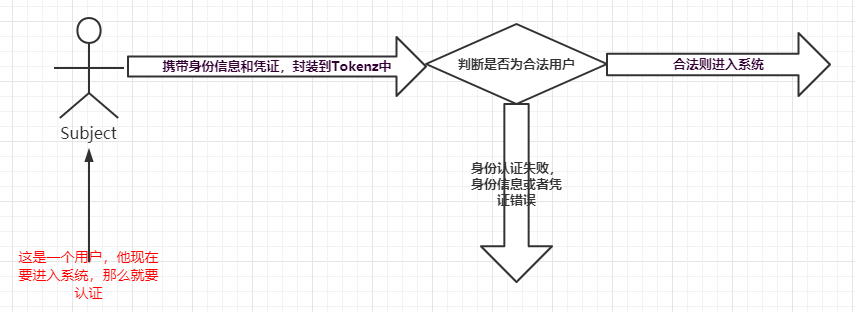
主体将身份信息和凭证封装到Token中,然后进行校验。
4-4 代码测试
环境:
IDEA+Maven+shiro1.5.3
首先在pom.xml中加入依赖:
<dependency> <groupId>org.apache.shiro</groupId> <artifactId>shiro-core</artifactId> <version>1.5.3</version> </dependency>
然后在resources中创建shiro.ini文件,并填充以下内容:
[users]
xiaochen=zhangsan
zhangsan=123456
创建TestAuthenticator类,内容如下:

1 public class TestAuthenticator { 2 3 public static void main(String[] args) { 4 5 /* 创建SecurityManager */ 6 DefaultSecurityManager securityManager = new DefaultSecurityManager(); 7 /* 设置Realm,这里设置的是iniRealm */ 8 securityManager.setRealm(new IniRealm("classpath:shiro.ini")); 9 /* 给安全工具类设置安全管理 */ 10 SecurityUtils.setSecurityManager(securityManager); 11 /* 获取当前的主体对象 */ 12 Subject subject = SecurityUtils.getSubject(); 13 /* 创建认证需要的Token */ 14 UsernamePasswordToken token = new UsernamePasswordToken("zhangsan", "21321"); 15 try { 16 /* 开始登陆 */ 17 subject.login(token); 18 } catch (UnknownAccountException e) { 19 e.printStackTrace(); 20 System.out.println("错误原因:账号不存在"); 21 } catch (IncorrectCredentialsException e){ 22 e.printStackTrace(); 23 System.out.println("错误原因:密码错误"); 24 } 25 26 } 27 }
然后我们运行时候会发现,用户名和密码信息是存放在Token中的,而我们的用户名和密码信息来源就是我们的shiro.ini文件,这个时候我们使用的Realm就是IniRealm,Realm就是数据源,不同的Realm获取数据的来源不一样,如果我们用户名和密码需要查询数据库的话,那么我们就可以自定义Realm。
我们认证的方法就是Subject的login方法,如果身份信息错误,那么抛出UnknownAccountException异常,凭证错误则抛出IncorrectCredentialsException异常,除此之外,还有其他的认证的异常。
例如:
-
-
LockedAccountException(帐号被锁定)
-
ExcessiveAttemptsException(登录失败次数过多)
-
4-5 自定义Realm
这里呢我们就要自定义Realm,自定义Realm就是为了自定义获取认证信息、授权信息的作用,比如说上面的例子,我们的用户数据是从shiro.ini文件中获取的,那么使用的Realm是IniRealm,现在我们要自定义获取的方法,那么就要自定义Realm,自定义Realm需要继承AuthorizingRealm这个抽象类,并实现其中的doGetAuthorizationInfo和doGetAuthenticationInfo方法,doGetAuthorizationInfo方法是用于获取授权信息的方法,doGetAuthenticationInfo是用于获取认证信息的方法。
TestCustomRealmForSecurity:

package com.shiro.demo2; import org.apache.shiro.SecurityUtils; import org.apache.shiro.authc.IncorrectCredentialsException; import org.apache.shiro.authc.UnknownAccountException; import org.apache.shiro.authc.UsernamePasswordToken; import org.apache.shiro.mgt.DefaultSecurityManager; import org.apache.shiro.subject.Subject; /** * 测试使用自定义Realm的Custom */ public class TestCustomRealmForSecurity { public static void main(String[] args) { // 创建安全管理器 DefaultSecurityManager securityManager = new DefaultSecurityManager(); // 给安全管理器设置自定义的realm securityManager.setRealm(new CustomRealm()); // 给安全工具类设置安全管理器 SecurityUtils.setSecurityManager(securityManager); // 通过SecurityUtil获取当前主体 Subject subject = SecurityUtils.getSubject(); // 创建UserNamePasswordToken用于登录 UsernamePasswordToken token = new UsernamePasswordToken("zhangsan","123456"); try { /* 开始登陆 */ subject.login(token); System.out.println("登陆成功!"); } catch (UnknownAccountException e) { e.printStackTrace(); System.out.println("错误原因:账号不存在"); } catch (IncorrectCredentialsException e){ e.printStackTrace(); System.out.println("错误原因:密码错误"); } } }
CustomRealm:

package com.shiro.demo2; import org.apache.shiro.authc.*; import org.apache.shiro.authz.AuthorizationInfo; import org.apache.shiro.realm.AuthorizingRealm; import org.apache.shiro.subject.PrincipalCollection; /** * 自定义Realm。继承于AuthorizingRealm */ public class CustomRealm extends AuthorizingRealm { /** * 获取授权信息的方法 * * @param principals 主体信息,可以获取当前用户的唯一身份信息 * @return 将用户的权限数据和角色数据封装到此对象中,并返回,如果不返回,则代表没有任何权限 */ @Override protected AuthorizationInfo doGetAuthorizationInfo(PrincipalCollection principals) { return null; } /** * 获取认证信息的方法 * * @param token 用户认证的时候封装的Token对象,我们这里使用的是UserNamePasswordToken * @return 我们将获取到的用户数据中的身份信息和凭证封装到此AuthenticationInfo对象中,返回给调用者,然后用来对比用户认证信息,如果返回null,那么就会抛出UnknownAccountException异常 * @throws AuthenticationException 认证错误异常,是所有认证期间异常的父类,我们的UnknownAccountException和IncorrectCredentialsException等异常都是它的儿子 */ @Override protected AuthenticationInfo doGetAuthenticationInfo(AuthenticationToken token) throws AuthenticationException { /*强转为UserNamePasswordToken*/ UsernamePasswordToken usernamePasswordToken = (UsernamePasswordToken) token; /*获取token中的用户数据,这里我们获取用户名,也就是身份信息*/ String username = (String) usernamePasswordToken.getPrincipal(); /*我们固定的*/ if ("zhangsan".equals(username)) { /* * 返回SimpleAuthenticationInfo对象, * 三个参数: * 1:用户身份信息 * 2:该用户的密码(数据库中的密码) * 3:该Subject的 * */ return new SimpleAuthenticationInfo(username,"123456",this.getName()); } return null; } }
我们可以发现,我们用户身份信息和凭证,都是在CustomeReal中设置的,而不是从shiro.ini中获取的。
4-5-1 为什么自定义Realm
首先我们要清楚,自定义Realm的时候,我们可以做什么。
我们自定义Realm了以后,就可以自定义获取认证信息、获取授权信息的方法,那么这个正是我们需要的,就比如登录,我们以后就需要在doGetAuthenticationInfo方法中根据用户名查询用户信息,然后再封装到返回info对象中,让shiro进行比对密码的认证操作。
所以我们需要自定义Realm。
4-5-2 Realm类结构图

4-6 认证时加入MD5和盐(salt)
大家都知道MD5加密,它可以将任意的文件加密成一串字符串,且不可逆,那么我们密码一般在数据库也是存的密文,不会存储明文。
那么将明文转为密文的操作呢就可以使用MD5的方式,先将用户密码加密为密文存储到数据库,然后登陆的时候,将密码再加密一次和数据库中已经加密好的数据进行比对,一致则说明正确。
那么这个MD5的不好的地方就是如果用户输入的密码比较简单,那么就很可能被破解,这个破解的方式并不是解密,而是使用已有的MD5加密结果一个一个比对,如果比如对到了那么就被破解了,这种方式不太靠谱,耗时长,但是如果加密前内容比较简单,那么隐患就比较大,所以我们MD5加密的时候需要配置着盐(slat)来处理。
盐就是一串字符,在原有明文上加上这串盐,再进行加密操作,登陆时候,将原有密码加上这串盐,再加密后和数据库比对。
盐和md5的一般搭配方式有,盐+明文->加密 | 明文+盐->加密 | 盐+明文+盐->加密 | 明文里夹杂着盐,盐使用散列的方式加进来。或者说你可以不止加盐,加用户名,手机号,生日,邮箱,地址等,统统都可以
然后我们加密的次数也可以多加几次,比如说我们要加密123,我们加密一次后,将结果再加密,通常加密1024或2048次,这样更安全(但没有绝对的安全,这个自行判定)。
然后就是代码的测试,我们先固定盐(盐在实际应用中都是随机的,故而需要存储到用户数据中)为“aqwe23f./?,”,明文密码为“123456”,加密次数为1024,那么加密后的结果就是:64b9c54630e9a09387f4db4b102e65aa
首先是加密明文的一个小工具类:
public static String getMD5(String source,String salt,int count){ return new Md5Hash(source,salt,count).toHex(); }
然后是CustomRealm:

package com.shiro.demo3; import org.apache.shiro.authc.*; import org.apache.shiro.authz.AuthorizationInfo; import org.apache.shiro.realm.AuthorizingRealm; import org.apache.shiro.subject.PrincipalCollection; import org.apache.shiro.util.ByteSource; /** */ public class CustomRealm extends AuthorizingRealm { /*授权*/ @Override protected AuthorizationInfo doGetAuthorizationInfo(PrincipalCollection principals) { return null; } /** * 获取认证信息的方法 */ @Override protected AuthenticationInfo doGetAuthenticationInfo(AuthenticationToken token) throws AuthenticationException { /*强转为UserNamePasswordToken*/ UsernamePasswordToken usernamePasswordToken = (UsernamePasswordToken) token; /*获取token中的用户数据,这里我们获取用户名,也就是身份信息*/ String username = (String) usernamePasswordToken.getPrincipal(); /*我们固定的*/ if ("zhangsan".equals(username)) { /** * 第一个参数:身份信息(用户名) * 第二个参数:凭证(数据库中存储的密文-->就是加密后的密码) * 第三个参数:盐,我们盐需要进行使用ByteSource.Util.bytes("盐")这方法转换为ByteSource * 第四个参数:当前realm名称,使用AuthorizingRealm的getName方法即可 */ return new SimpleAuthenticationInfo(username,"64b9c54630e9a09387f4db4b102e65aa", ByteSource.Util.bytes("aqwe23f./?,"),this.getName()); } return null; } }
然后是TestMD5Security:

package com.shiro.demo3; import org.apache.shiro.SecurityUtils; import org.apache.shiro.authc.IncorrectCredentialsException; import org.apache.shiro.authc.UnknownAccountException; import org.apache.shiro.authc.UsernamePasswordToken; import org.apache.shiro.authc.credential.HashedCredentialsMatcher; import org.apache.shiro.mgt.DefaultSecurityManager; import org.apache.shiro.subject.Subject; /** * 测试mo5加密的认证方式 */ public class TestMD5Security { public static void main(String[] args) { // 创建安全管理器 DefaultSecurityManager securityManager = new DefaultSecurityManager(); // 创建Realm CustomRealm realm = new CustomRealm(); // ============给Realm设置加密的代码============ // 创建验证器 HashedCredentialsMatcher hashedCredentialsMatcher = new HashedCredentialsMatcher(); // 设置加密类型名称 hashedCredentialsMatcher.setHashAlgorithmName("MD5"); // 设置加密次数 hashedCredentialsMatcher.setHashIterations(1024); // 给realm设置验证器 realm.setCredentialsMatcher(hashedCredentialsMatcher); // ============给Realm设置加密的代码结束============ // 给安全管理器设置自定义的realm securityManager.setRealm(realm); // 给安全工具类设置安全管理器 SecurityUtils.setSecurityManager(securityManager); // 通过SecurityUtil获取当前主体 Subject subject = SecurityUtils.getSubject(); // 创建UserNamePasswordToken用于登录 UsernamePasswordToken token = new UsernamePasswordToken("zhangsan","123456"); try { /* 开始登陆 */ subject.login(token); System.out.println("登陆成功!"); } catch (UnknownAccountException e) { e.printStackTrace(); System.out.println("错误原因:账号不存在"); } catch (IncorrectCredentialsException e){ e.printStackTrace(); System.out.println("错误原因:密码错误"); } } }
需要注意的是,我们在将realm设置给SecurityManager之前,需要给Realm设置密码匹配器,然后在realm中返回AuthenticationInfo信息对象的时候,需要将盐传参数传给它。
5 授权
5-1 授权的认识
授权,也就是访问控制,控制谁能访问哪些资源,这个”谁“是认证后的主体/用户,在访问受限资源(受限制的资源或需要经过授权后才能访问的资源)以前,需要先经过授权。
5-2 关键对象
也就是who对what进行how操作。
who:即主体Subject,主体需要访问系统中的资源
what:即资源Resource,如某个请求,按钮,方法等,资源包括资源类型和资源实例,比如商品信息为资源类型,id为1的商品为资源实例。
how:即权限Permission,规定了主体对资源的操作许可,权限离开了资源是没有意义的。权限这个比如:查询用户权限、添加用户权限等。
5-3 授权的流程

5-4 授权的方式
- 基于角色的访问控制
- RBAC基于角色的访问控制(Role-Based Access Control)是以角色为中心进行访问控制
-
if(subject.hasRole("admin")){ //操作什么资源 }
- 基于资源的访问控制
- RBAC基于资源的访问控制(Resource-Based Access Control)是以资源为中心进行访问控制
-
if(subject.isPermission("user:update:01")){ //资源实例 //对01用户进行修改 } if(subject.isPermission("user:update:*")){ //资源类型 //对01用户进行修改 }
5-5 权限字符串
我们上面就使用了权限字符串,它的格式为:权限标识符:操作:资源实例标识符,意思是对哪个资源的哪个操作有哪些具体的操作,”:“是资源/操作/实例的分隔符,权限字符串中”*“代表着通配符,也就是所有的意思。
例如:
- 用户创建权限:user:create或user:create:*
- 查询所有用户权限:user:select:*
- 对1的这个用户的所有权限:user:*:1
- 对所有用户的所有权限:user:*:*
5-6 shiro中检查授权是否拥有的实现方式
编程式:
Subject subject = SecurityUtils.getSubject(); if(subject.hasRole(“admin”)) { //有权限 } else { //无权限 }
注解式:
@RequiresRoles("admin")
public void hello() {
//有权限
}
标签式:
JSP/GSP 标签:在JSP/GSP 页面通过相应的标签完成: <shiro:hasRole name="admin"> <!— 有权限—> </shiro:hasRole> 注意: Thymeleaf 中使用shiro需要额外集成!
5-7 代码测试
CustomRealm:

1 package com.shiro.demo4; 2 3 import org.apache.shiro.authc.*; 4 import org.apache.shiro.authz.AuthorizationInfo; 5 import org.apache.shiro.authz.SimpleAuthorizationInfo; 6 import org.apache.shiro.realm.AuthorizingRealm; 7 import org.apache.shiro.subject.PrincipalCollection; 8 import org.apache.shiro.util.ByteSource; 9 10 /** 11 */ 12 public class CustomRealm extends AuthorizingRealm { 13 14 /*授权*/ 15 @Override 16 protected AuthorizationInfo doGetAuthorizationInfo(PrincipalCollection principals) { 17 // 获得当前认证后的主体/用户的唯一身份标识,也就是用户名 18 String username = (String) principals.getPrimaryPrincipal(); 19 // 需要返回的信息对象,此对象中包含了权限信息和角色信息 20 SimpleAuthorizationInfo simpleAuthorizationInfo = new SimpleAuthorizationInfo(); 21 simpleAuthorizationInfo.addRole("admin"); 22 simpleAuthorizationInfo.addStringPermission("user:update:01"); 23 simpleAuthorizationInfo.addStringPermission("user:delete:*"); 24 // 不要忘记返回 25 return simpleAuthorizationInfo; 26 } 27 28 /** 29 * 获取认证信息的方法 30 */ 31 @Override 32 protected AuthenticationInfo doGetAuthenticationInfo(AuthenticationToken token) throws AuthenticationException { 33 /*强转为UserNamePasswordToken*/ 34 UsernamePasswordToken usernamePasswordToken = (UsernamePasswordToken) token; 35 /*获取token中的用户数据,这里我们获取用户名,也就是身份信息*/ 36 String username = (String) usernamePasswordToken.getPrincipal(); 37 /*我们固定的*/ 38 if ("zhangsan".equals(username)) { 39 /** 40 * 第一个参数:身份信息(用户名) 41 * 第二个参数:凭证(数据库中存储的密文-->就是加密后的密码) 42 * 第三个参数:盐,我们盐需要进行使用ByteSource.Util.bytes("盐")这方法转换为ByteSource 43 * 第四个参数:当前realm名称,使用AuthorizingRealm的getName方法即可 44 */ 45 return new SimpleAuthenticationInfo(username,"64b9c54630e9a09387f4db4b102e65aa", ByteSource.Util.bytes("aqwe23f./?,"),this.getName()); 46 } 47 return null; 48 } 49 }
注意,给当前用户授权的时候,在doGetAuthorizationInfo方法中书写逻辑。
TestAuthorizationSecurity:

1 package com.shiro.demo4; 2 3 import org.apache.shiro.SecurityUtils; 4 import org.apache.shiro.authc.IncorrectCredentialsException; 5 import org.apache.shiro.authc.UnknownAccountException; 6 import org.apache.shiro.authc.UsernamePasswordToken; 7 import org.apache.shiro.authc.credential.HashedCredentialsMatcher; 8 import org.apache.shiro.mgt.DefaultSecurityManager; 9 import org.apache.shiro.subject.Subject; 10 11 /** 12 * 测试授权 13 */ 14 public class TestAuthorizationSecurity { 15 public static void main(String[] args) { 16 // 创建安全管理器 17 DefaultSecurityManager securityManager = new DefaultSecurityManager(); 18 // 创建Realm 19 CustomRealm realm = new CustomRealm(); 20 // ============给Realm设置加密的代码============ 21 // 创建验证器 22 HashedCredentialsMatcher hashedCredentialsMatcher = new HashedCredentialsMatcher(); 23 // 设置加密类型名称 24 hashedCredentialsMatcher.setHashAlgorithmName("MD5"); 25 // 设置加密次数 26 hashedCredentialsMatcher.setHashIterations(1024); 27 // 给realm设置验证器 28 realm.setCredentialsMatcher(hashedCredentialsMatcher); 29 // ============给Realm设置加密的代码结束============ 30 // 给安全管理器设置自定义的realm 31 securityManager.setRealm(realm); 32 // 给安全工具类设置安全管理器 33 SecurityUtils.setSecurityManager(securityManager); 34 // 通过SecurityUtil获取当前主体 35 Subject subject = SecurityUtils.getSubject(); 36 // 创建UserNamePasswordToken用于登录 37 UsernamePasswordToken token = new UsernamePasswordToken("zhangsan","123456"); 38 try { 39 /* 开始登陆 */ 40 subject.login(token); 41 System.out.println("登陆成功!"); 42 } catch (UnknownAccountException e) { 43 e.printStackTrace(); 44 System.out.println("错误原因:账号不存在"); 45 } catch (IncorrectCredentialsException e){ 46 e.printStackTrace(); 47 System.out.println("错误原因:密码错误"); 48 } 49 /*到达这里的时候,说明认证成功,也就是登陆成功,我们开始来判断权限*/ 50 // 是否含有admin这个角色 51 System.out.println(subject.hasRole("admin")); 52 // 是否含有对01用户的更新权限 53 System.out.println(subject.isPermitted("user:update:01")); 54 // 是否含有更新所有用户的权限 55 System.out.println(subject.isPermitted("user:update:*")); 56 // 是否含有删除01用户的权限 57 System.out.println(subject.isPermitted("user:delete:01")); 58 // 是否含有对所有用户的删除权限 59 System.out.println(subject.isPermitted("user:delete:*")); 60 } 61 }
多试试添加不同的权限。
6 SpringBoot整合Shiro
6-1 创建SpringBoot项目
可以使用脚手架,也可以创建maven后手动加配置文件。
pom.xml:

<dependencies>
<dependency>
<groupId>org.springframework.boot</groupId>
<artifactId>spring-boot-starter-web</artifactId>
<exclusions>
<exclusion>
<groupId>org.springframework.boot</groupId>
<artifactId>spring-boot-starter-logging</artifactId>
</exclusion>
</exclusions>
</dependency>
<dependency>
<groupId>org.projectlombok</groupId>
<artifactId>lombok</artifactId>
</dependency>
<dependency>
<groupId>org.springframework.boot</groupId>
<artifactId>spring-boot-starter-test</artifactId>
</dependency>
<dependency>
<groupId>org.apache.commons</groupId>
<artifactId>commons-lang3</artifactId>
</dependency>
<!-- log4j -->
<dependency>
<groupId>org.springframework.boot</groupId>
<artifactId>spring-boot-starter-log4j</artifactId>
<version>1.3.8.RELEASE</version>
</dependency>
<dependency>
<groupId>org.springframework.boot</groupId>
<artifactId>spring-boot-starter-thymeleaf</artifactId>
</dependency>
</dependencies>
然后在templates下创建index.html,然后用controller跳转,确保项目是没有问题的。
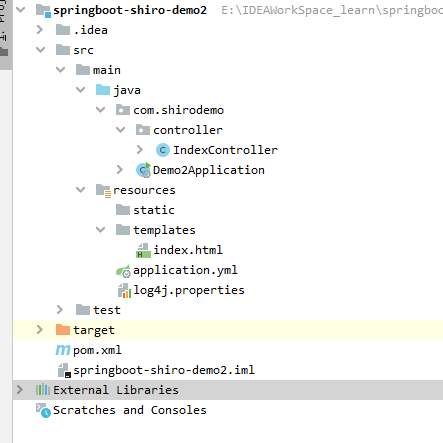
6-2 导入依赖
现在就来导入shiro的start,pom.xml:

<dependency>
<groupId>org.apache.shiro</groupId>
<artifactId>shiro-spring-boot-starter</artifactId>
<version>1.5.3</version>
</dependency>
6-3 配置环境
然后在目录下创建一个config目录,用来放置shiro的配置类:
1、创建配置类:
public class ShiroConfig {
}
2、创建自定义Realm类:

package com.shirodemo.config.shiro.realm; import org.apache.shiro.authc.AuthenticationException; import org.apache.shiro.authc.AuthenticationInfo; import org.apache.shiro.authc.AuthenticationToken; import org.apache.shiro.authz.AuthorizationInfo; import org.apache.shiro.realm.AuthorizingRealm; import org.apache.shiro.subject.PrincipalCollection; /** * 自定义Realm */ public class CustomRealm extends AuthorizingRealm { @Override protected AuthorizationInfo doGetAuthorizationInfo(PrincipalCollection principals) { return null; } @Override protected AuthenticationInfo doGetAuthenticationInfo(AuthenticationToken token) throws AuthenticationException { return null; } }
3、在ShiroConfig中加入配置方法(配置Realm、SecurityManager、ShiroFilterFactoryBean):

package com.shirodemo.config.shiro; import com.shirodemo.config.shiro.realm.CustomRealm; import org.apache.shiro.mgt.SecurityManager; import org.apache.shiro.realm.Realm; import org.apache.shiro.spring.web.ShiroFilterFactoryBean; import org.apache.shiro.web.mgt.DefaultWebSecurityManager; import org.springframework.context.annotation.Bean; import org.springframework.context.annotation.Configuration; /* * Shiro的配置类 * */ @Configuration public class ShiroConfig { /* * 配置ShiroFilterFactoryBean * */ @Bean public ShiroFilterFactoryBean getShiroFilterFactoryBean(SecurityManager securityManager) { ShiroFilterFactoryBean shiroFilterFactoryBean = new ShiroFilterFactoryBean(); shiroFilterFactoryBean.setSecurityManager(securityManager); return shiroFilterFactoryBean; } /* * 配置WebSecurityManager * */ @Bean public DefaultWebSecurityManager getDefaultWebSecurityManager(Realm realm) { DefaultWebSecurityManager defaultWebSecurityManager = new DefaultWebSecurityManager(); // 设置Realm defaultWebSecurityManager.setRealm(realm); return defaultWebSecurityManager; } /** * 配置自定义Realm */ @Bean public Realm getRealm() { CustomRealm customRealm = new CustomRealm(); return customRealm; } }
6-4 创建需要的文件和资源
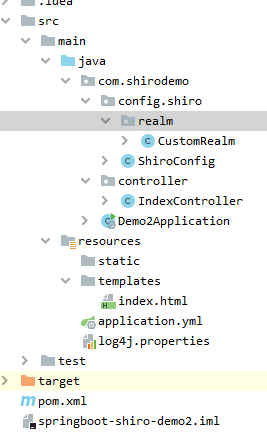
这是最终效果,加入一个index.html,然后加入controller转发,成功看到页面才代表配置正确,正常运行。
我们运行后发现index.html是可以运行的,因为我们还没有对认证和授权进行配置,那么默认所有资源都是可访问的。
6-5 资源权限约定
我们假设现有一个用户,用户名giaoge,密码123。
6-6 配置认证控制测试效果
我们在ShiroConfg的getShiroFilterFactoryBean方法修改一些代码,也就是需要加入权限控制的代码:
/* * 配置ShiroFilterFactoryBean * */ @Bean public ShiroFilterFactoryBean getShiroFilterFactoryBean(SecurityManager securityManager) { ShiroFilterFactoryBean shiroFilterFactoryBean = new ShiroFilterFactoryBean(); shiroFilterFactoryBean.setSecurityManager(securityManager); /*==================*/ Map<String,String> map = new LinkedHashMap<>(); map.put("/**","authc"); shiroFilterFactoryBean.setFilterChainDefinitionMap(map); return shiroFilterFactoryBean; }
然后测试效果:
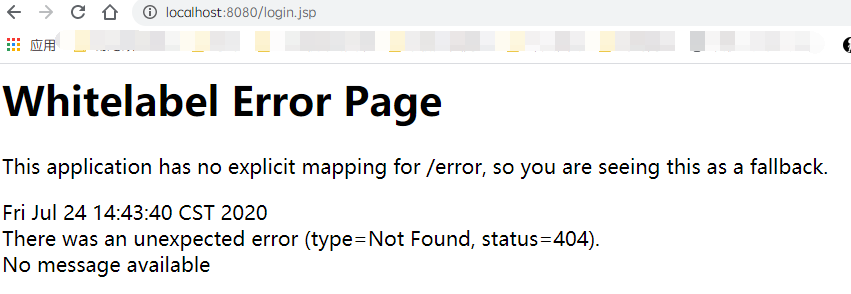
我们会发现当我们访问index.html的时候,它会自动地跳转到login.jsp,为什么呢?
因为我们加入了认证的控制,/**代表的就是所有请求,authc代表着一个过滤器,那么我们访问/**请求的时候,就会经过authc这个过滤器,这个过滤器要求当前用户已经认证,如果没有认证那么就会跳转到认证页面(登陆页面)。
但是我们注意,我们并没有设置认证页面的路径,它为什么会跳转到login.jsp呢,因为如果shiro对于认证页面有一个默认的路径,就是/login.jsp,当然我们在代码中也可以设则认证页面的路径,shiroFilterFactoryBean.setLoginUrl("认证页面路径");
6-7 shiro中常见过滤器
| 对应的过滤器 | 功能 | |
|---|---|---|
| anon | AnonymousFilter | 指定url可以匿名访问 |
| authc | FormAuthenticationFilter | 指定url需要form表单登录,默认会从请求中获取username、password,rememberMe等参数并尝试登录,如果登录不了就会跳转到loginUrl配置的路径。我们也可以用这个过滤器做默认的登录逻辑,但是一般都是我们自己在控制器写登录逻辑的,自己写的话出错返回的信息都可以定制嘛。 |
| authcBasic | BasicHttpAuthenticationFilter | 指定url需要basic登录 |
| logout | LogoutFilter | 登出过滤器,配置指定url就可以实现退出功能,非常方便 |
| noSessionCreation | NoSessionCreationFilter | 禁止创建会话 |
| perms | PermissionsAuthorizationFilter | 需要指定权限才能访问 |
| port | PortFilter | 需要指定端口才能访问 |
| rest | HttpMethodPermissionFilter | 将http请求方法转化成相应的动词来构造一个权限字符串,这个感觉意义不大,有兴趣自己看源码的注释 |
| roles | RolesAuthorizationFilter | 需要指定角色才能访问 |
| ssl | SslFilter | 需要https请求才能访问 |
| user | UserFilter |
6-8 认证的实现
注意我们前面有约定,我们先不查询数据库,暂定用户名为username,密码为123。
1、加入登陆页面,然后用一个Controller来访问该页面,路径为/login.html,然后在ShiroConfig中的getShiroFilterFactoryBean方法中加入如下代码:shiroFilterFactoryBean.setLoginUrl("login.html");代表着设置认证页面为/login.html

首先需要一个注册页面login.html:

<!DOCTYPE html>
<html lang="en">
<head>
<meta charset="UTF-8">
<title>登陆页面</title>
</head>
<body>
<center>
<h1>登陆页面</h1>
<form action="/login" method="post">
<table border="1">
<th>
<td colspan="2" style="text-align: center">登录</td>
</th>
<tr>
<td>登录名:</td>
<td><input type="text" name="username"></td>
</tr>
<tr>
<td>密码:</td>
<td><input type="text" name="password"></td>
</tr>
<tr>
<td colspan="2"><input type="submit" value="登录"></td>
</tr>
</table>
</form>
</center>
</body>
</html>
然后创建一个LoginController用于处理登录请求:

package com.shirodemo.controller; import org.apache.shiro.SecurityUtils; import org.apache.shiro.authc.AuthenticationException; import org.apache.shiro.authc.IncorrectCredentialsException; import org.apache.shiro.authc.UnknownAccountException; import org.apache.shiro.authc.UsernamePasswordToken; import org.apache.shiro.subject.Subject; import org.springframework.stereotype.Controller; import org.springframework.web.bind.annotation.PostMapping; /** * */ @Controller public class LoginController { // 登录的Controller,也可以说是处理身份认证 @PostMapping("/login") public String login(String username, String password) { // 获取主体对象/当前用户 Subject subject = SecurityUtils.getSubject(); // 封装成Token UsernamePasswordToken token = new UsernamePasswordToken(username, password); try { // 调用login方法去认证 subject.login(token); System.out.println("登陆成功!"); // 重定向到首页 return "redirect:/index.html"; } catch (UnknownAccountException e) { System.out.println("用户名不存在!"); e.printStackTrace(); } catch (IncorrectCredentialsException e) { System.out.println("密码错误!"); e.printStackTrace(); } catch (AuthenticationException e) { System.out.println("认证时出现异常!"); e.printStackTrace(); } return "redirect:/login.html"; } }
然后更改Realm的doGetAuthenticationInfo方法的代码:

@Override protected AuthenticationInfo doGetAuthenticationInfo(AuthenticationToken token) throws AuthenticationException { String username = (String) token.getPrincipal(); if ("giaoge".equals(username)) { return new SimpleAuthenticationInfo(username, "123", this.getName()); } return null; }
最重要的地方,不要忘记在ShrioConfig中更改添加权限控制,放行/login.html和/login,并且给/login.html设置人认证页面。

/* * 配置ShiroFilterFactoryBean * */ @Bean public ShiroFilterFactoryBean getShiroFilterFactoryBean(SecurityManager securityManager) { ShiroFilterFactoryBean shiroFilterFactoryBean = new ShiroFilterFactoryBean(); shiroFilterFactoryBean.setSecurityManager(securityManager); shiroFilterFactoryBean.setLoginUrl("/login.html"); /*==================*/ Map<String,String> map = new LinkedHashMap<>(); map.put("/login.html","anon"); // 指定login.html这个是公开的资源 map.put("/login","anon"); // 指定login这个是公开的资源 map.put("/**","authc"); shiroFilterFactoryBean.setFilterChainDefinitionMap(map); return shiroFilterFactoryBean; }
然后运行测试,就会发现如果,只有通过giaoge,123这个账号通过登录后才能进入index.html,否则就不能访问除了/login.html,/login这两个请求以外的资源。
6-9 退出认证
退出认证我们使用的是subject的logout方法。
在index.html中加入一个a标签:
<a href="/logout">退出认证</a>
在LoginController中加入退出登录的方法:
/** * 退出认证 */ @GetMapping("/logout") public String logout(){ Subject subject = SecurityUtils.getSubject(); // 调用subject的logout方法退出登录, subject.logout(); return "redirect:/login.html"; }
就可以测试到退出登录的效果了。
6-10 认证时加入MD5和盐
我们约定盐是:
aqwe23f./?,
我们的明文密码和加密后的密码分别是:
123
0ae8a3afcf827511169db374c489b09d
加密次数为1024次。
然后修改ShiroConfig中的getRealm方法:

/** * 配置自定义Realm */ @Bean public Realm getRealm() { CustomRealm customRealm = new CustomRealm(); // 创建验证器 HashedCredentialsMatcher hashedCredentialsMatcher = new HashedCredentialsMatcher(); // 设置加密类型名称 hashedCredentialsMatcher.setHashAlgorithmName("MD5"); // 设置加密次数 hashedCredentialsMatcher.setHashIterations(1024); // 给realm设置验证器 customRealm.setCredentialsMatcher(hashedCredentialsMatcher); return customRealm; }
然后修改CustomRealm中的认证方法中返回的SimpleAuthenticationInfo对象:

@Override protected AuthenticationInfo doGetAuthenticationInfo(AuthenticationToken token) throws AuthenticationException { String username = (String) token.getPrincipal(); if ("giaoge".equals(username)) { return new SimpleAuthenticationInfo(username, "0ae8a3afcf827511169db374c489b09d", ByteSource.Util.bytes("aqwe23f./?,"), this.getName()); } return null; }
然后查看认证的效果。
6-11 授权实现
6-11-1 页面资源方式权限控制
如果是jsp页面,直接引入标签库,然后就可以使用,如果是thymlef,文章末尾会讲解如何使用:

<%@taglib prefix="shiro" uri="http://shiro.apache.org/tags" %>
<shiro:hasAnyRoles name="user,admin">
<li><a href="">用户管理</a>
<ul>
<shiro:hasPermission name="user:add:*">
<li><a href="">添加</a></li>
</shiro:hasPermission>
<shiro:hasPermission name="user:delete:*">
<li><a href="">删除</a></li>
</shiro:hasPermission>
<shiro:hasPermission name="user:update:*">
<li><a href="">修改</a></li>
</shiro:hasPermission>
<shiro:hasPermission name="user:find:*">
<li><a href="">查询</a></li>
</shiro:hasPermission>
</ul>
</li>
</shiro:hasAnyRoles>
<shiro:hasRole name="admin">
<li><a href="">商品管理</a></li>
<li><a href="">订单管理</a></li>
<li><a href="">物流管理</a></li>
</shiro:hasRole>
6-11-2 代码方式权限控制
使用subject的hasRole等方法进行判断是否含有角色、权限:

@RequestMapping("save")
public String save(){
System.out.println("进入方法");
//获取主体对象
Subject subject = SecurityUtils.getSubject();
//代码方式
if (subject.hasRole("admin")) {
System.out.println("保存订单!");
}else{
System.out.println("无权访问!");
}
//基于权限字符串
//....
return "redirect:/index.jsp";
}
6-11-3 方法调用方式权限控制
在请求方法上加入注解:

@RequiresRoles(value={"admin","user"})//用来判断角色 同时具有 admin user
@RequiresPermissions("user:update:01") //用来判断权限字符串
@RequestMapping("save")
public String save(){
System.out.println("进入方法");
return "redirect:/index.jsp";
}
6-11-4 测试权限控制
修改首页html.html:

<!DOCTYPE html>
<html lang="en">
<head>
<meta charset="UTF-8">
<title>首页</title>
</head>
<body>
<center>
<h1>首页</h1>
<a href="/logout">退出认证</a>
<br>
<br>
<a href="/userManager">用户管理</a>
<br>
<a href="/productManager">商品管理</a>
<br>
<a href="/stockManager">库存管理</a>
</center>
</body>
</html>
添加TestController用来测试请求授权:

package com.shirodemo.controller; import org.apache.shiro.authz.annotation.Logical; import org.apache.shiro.authz.annotation.RequiresRoles; import org.springframework.web.bind.annotation.GetMapping; import org.springframework.web.bind.annotation.RestController; /** * 测试的Controller */ @RestController public class TestController { // 用户管理 @GetMapping("/userManager") // 含有admin或者user角色则可以访问 @RequiresRoles(value = {"admin","user"}, logical = Logical.OR) public String userManager() { return "用户管理"; } // 商品管理 @GetMapping("/productManager") // 含有admin或者product角色则可以访问 @RequiresRoles(value = {"admin","product"}, logical = Logical.OR) public String productManager() { return "商品管理"; } // 库存管理 @GetMapping("/stockManager") // 含有admin或者product角色则可以访问 @RequiresRoles(value = {"admin","stock"}, logical = Logical.OR) public String stockManager() { return "库存管理"; } }
修改CustomRealm的doGetAuthorizationInfo方法内容:

@Override protected AuthorizationInfo doGetAuthorizationInfo(PrincipalCollection principals) { // 获得唯一的主体信息 String username = (String) principals.getPrimaryPrincipal(); // 创建返回信息对象 SimpleAuthorizationInfo simpleAuthorizationInfo = new SimpleAuthorizationInfo(); simpleAuthorizationInfo.addRole("user"); return simpleAuthorizationInfo; }
然后我们就可以发现,如果权限不足,那么会抛出org.apache.shiro.authz.AuthorizationException这个异常,那么我们就给mvc设置一个全局异常处理,然后捕获这个异常,再判断是ajax或者普通请求来判断返回数据还是跳转提示页面。
我这里为了懒,就不贴判断是不是ajax了,直接返回固定提示页面。

/** */ @ControllerAdvice public class ExceptionHandler { @org.springframework.web.bind.annotation.ExceptionHandler(AuthorizationException.class) public String handlerAuthorizationException(AuthorizationException e){ System.out.println("请求被拒绝:" + e.getMessage()); return "/permissionRefuse.html"; } }
页面和跳转controller自定。
6-11-5 结合数据库表来测试授权实现
代码修改太多,所以直接下载包导入idea看:
6-12 使用CacheManager
6-12-1 作用
其实我们授权的时候会发现,每次访问需要权限的请求的时候,都会去调用获取授权信息的方法,这样就会导致数据库的压力变大,我们希望的是,授权信息只获取一次,获取了一次后就放置到缓存中,后面需要授权信息的时候,直接从缓存中拿就行。
6-12-2 Shiro默认的本地缓存EhCache
6-12-2-1 引入依赖

<!--引入shiro和ehcache--> <dependency> <groupId>org.apache.shiro</groupId> <artifactId>shiro-ehcache</artifactId> <version>1.5.3</version> </dependency>
6-12-2-2 开启缓存
修改shiroconfig中创建CustomRealm那个方法的代码:

/** * 配置自定义Realm */ @Bean public Realm getRealm() { CustomRealm customRealm = new CustomRealm(); // 创建验证器 HashedCredentialsMatcher hashedCredentialsMatcher = new HashedCredentialsMatcher(); // 设置加密类型名称 hashedCredentialsMatcher.setHashAlgorithmName("MD5"); // 设置加密次数 hashedCredentialsMatcher.setHashIterations(1024); /*=============================================*/ // 开启缓存管理器 // 缓存总开关 customRealm.setCachingEnabled(true); // 设置认证的缓存开关 customRealm.setAuthenticationCachingEnabled(true); // 设置授权的缓存开关 customRealm.setAuthorizationCachingEnabled(true); // 设置缓存管理器,默认是本地缓存管理器 customRealm.setCacheManager(new EhCacheManager()); /*=============================================*/ // 给realm设置验证器 customRealm.setCredentialsMatcher(hashedCredentialsMatcher); return customRealm; }
6-12-2-3 测试
可以发现我们的授权查询方法只被调用了一次。
6-12-3 使用Redis作为缓存实现
6-12-3-1 引入依赖

<!--redis整合springboot--> <dependency> <groupId>org.springframework.boot</groupId> <artifactId>spring-boot-starter-data-redis</artifactId> </dependency>
6-12-3-2 配置Redis相关

spring: redis: host: localhost port: 6379 database: 0 password:
6-12-3-3 自定义缓存管理器(CacheManager)和缓存实现(Cache)
创建RedisCache继承于Cache:

package com.shirodemo.config.shiro.cache; import org.apache.shiro.cache.Cache; import org.apache.shiro.cache.CacheException; import org.springframework.beans.factory.annotation.Autowired; import org.springframework.boot.SpringApplication; import org.springframework.context.ApplicationContext; import org.springframework.data.redis.core.RedisTemplate; import org.springframework.data.redis.serializer.StringRedisSerializer; import org.springframework.stereotype.Component; import org.springframework.web.context.support.WebApplicationContextUtils; import java.util.Collection; import java.util.Set; /** * 自定义的redis缓存操作类 */ public class RedisCache<K, V> implements Cache<K, V> { private RedisTemplate redisTemplate; private String cacheName = "shiro_cache_redis_prefix_"; public RedisCache() { } public RedisCache(RedisTemplate redisTemplate) { this.redisTemplate = redisTemplate; } @Override public V get(K k) throws CacheException { return (V) redisTemplate.opsForHash().get(this.cacheName, k.toString()); } @Override public V put(K k, V v) throws CacheException { redisTemplate.opsForHash().put(this.cacheName, k.toString(), v); return null; } @Override public V remove(K k) throws CacheException { return (V) redisTemplate.opsForHash().delete(this.cacheName, k.toString()); } @Override public void clear() throws CacheException { redisTemplate.delete(this.cacheName); } @Override public int size() { return redisTemplate.opsForHash().size(this.cacheName).intValue(); } @Override public Set<K> keys() { return redisTemplate.opsForHash().keys(this.cacheName); } @Override public Collection<V> values() { return redisTemplate.opsForHash().values(this.cacheName); } }
创建RedisManager实现CacheManager:

package com.shirodemo.config.shiro.cache; import org.apache.shiro.cache.Cache; import org.apache.shiro.cache.CacheException; import org.apache.shiro.cache.CacheManager; /** * 自定义的缓存管理器 */ public class RedisManager implements CacheManager { private RedisCache redisCache; public RedisManager(RedisCache redisCache) { this.redisCache = redisCache; } @Override public <K, V> Cache<K, V> getCache(String s) throws CacheException { return redisCache; } }
在ShiroConfig中加入一个getCacheManager方法:

/* * 自定义redis缓存管理器 * */ @Bean public CacheManager getCacheManager(RedisTemplate redisTemplate) { redisTemplate.setKeySerializer(new StringRedisSerializer()); redisTemplate.setHashKeySerializer(new StringRedisSerializer()); RedisCache redisCache = new RedisCache(redisTemplate); RedisManager redisManager = new RedisManager(redisCache); return redisManager; }
然后在配置realm的方法中,修改代码为:

/** * 配置自定义Realm */ @Bean public Realm getRealm(CacheManager cacheManager) { CustomRealm customRealm = new CustomRealm(); // 创建验证器 HashedCredentialsMatcher hashedCredentialsMatcher = new HashedCredentialsMatcher(); // 设置加密类型名称 hashedCredentialsMatcher.setHashAlgorithmName("MD5"); // 设置加密次数 hashedCredentialsMatcher.setHashIterations(1024); /*=============================================*/ // 开启缓存管理器 // 缓存总开关 customRealm.setCachingEnabled(true); // 设置认证的缓存开关 customRealm.setAuthenticationCachingEnabled(true); // 设置授权的缓存开关 customRealm.setAuthorizationCachingEnabled(true); // 设置缓存管理器,默认是本地缓存管理器 customRealm.setCacheManager(cacheManager); /*=============================================*/ // 给realm设置验证器 customRealm.setCredentialsMatcher(hashedCredentialsMatcher); return customRealm; }
6-12-3-4 如遇见SimpleByteSource未序列化错误请看这里
因为SimpleByteSource没有直接或间接的实现序列化接口,所以我们创建MySimpleByteSource类自己去实现于ByteSource,并实现Serializable类:

package com.shirodemo.config.shiro.salt; import org.apache.shiro.codec.Base64; import org.apache.shiro.codec.CodecSupport; import org.apache.shiro.codec.Hex; import org.apache.shiro.util.ByteSource; import org.apache.shiro.util.SimpleByteSource; import java.io.File; import java.io.InputStream; import java.io.Serializable; import java.util.Arrays; /** * 自定义ByteSource */ public class MySimpleByteSource implements ByteSource, Serializable { private byte[] bytes; private String cachedHex; private String cachedBase64; public MySimpleByteSource(){ } public MySimpleByteSource(byte[] bytes) { this.bytes = bytes; } public MySimpleByteSource(char[] chars) { this.bytes = CodecSupport.toBytes(chars); } public MySimpleByteSource(String string) { this.bytes = CodecSupport.toBytes(string); } public MySimpleByteSource(ByteSource source) { this.bytes = source.getBytes(); } public MySimpleByteSource(File file) { this.bytes = (new MySimpleByteSource.BytesHelper()).getBytes(file); } public MySimpleByteSource(InputStream stream) { this.bytes = (new MySimpleByteSource.BytesHelper()).getBytes(stream); } public static boolean isCompatible(Object o) { return o instanceof byte[] || o instanceof char[] || o instanceof String || o instanceof ByteSource || o instanceof File || o instanceof InputStream; } public byte[] getBytes() { return this.bytes; } public boolean isEmpty() { return this.bytes == null || this.bytes.length == 0; } public String toHex() { if (this.cachedHex == null) { this.cachedHex = Hex.encodeToString(this.getBytes()); } return this.cachedHex; } public String toBase64() { if (this.cachedBase64 == null) { this.cachedBase64 = Base64.encodeToString(this.getBytes()); } return this.cachedBase64; } public String toString() { return this.toBase64(); } public int hashCode() { return this.bytes != null && this.bytes.length != 0 ? Arrays.hashCode(this.bytes) : 0; } public boolean equals(Object o) { if (o == this) { return true; } else if (o instanceof ByteSource) { ByteSource bs = (ByteSource)o; return Arrays.equals(this.getBytes(), bs.getBytes()); } else { return false; } } private static final class BytesHelper extends CodecSupport { private BytesHelper() { } public byte[] getBytes(File file) { return this.toBytes(file); } public byte[] getBytes(InputStream stream) { return this.toBytes(stream); } } }
然后在CustomRealm中,修改返回info对象的那行代码为:
return new SimpleAuthenticationInfo(user, user.getPassword(), new MySimpleByteSource(user.getSalt()), this.getName());
6-12-3-5 测试
发现我们的缓存被放置到了redis中。
6-12-4 图片验证码(可选)
按照常规验证码来弄就行,还是存在session中,代码就不写了。
7 Thymeleaf中使用Shiro标签
7-1 引入依赖

<dependency>
<groupId>com.github.theborakompanioni</groupId>
<artifactId>thymeleaf-extras-shiro</artifactId>
<version>2.0.0</version>
</dependency>
7-2 配置方言

// 配置thymeleaf的方言 @Bean(name = "shiroDialect") public ShiroDialect shiroDialect(){ return new ShiroDialect(); }
7-3 页面引入命名空间和常用标签

<html xmlns="http://www.w3.org/1999/xhtml" xmlns:th="http://www.thymeleaf.org"
xmlns:shiro="http://www.pollix.at/thymeleaf/shiro">
<!-- 验证当前用户是否为“访客”,即未认证(包含未记住)的用户。 --> <p shiro:guest="">Please <a href="login.html">login</a></p> <!-- 认证通过或已记住的用户。 --> <p shiro:user=""> Welcome back John! Not John? Click <a href="login.html">here</a> to login. </p> <!-- 已认证通过的用户。不包含已记住的用户,这是与user标签的区别所在。 --> <p shiro:authenticated=""> Hello, <span shiro:principal=""></span>, how are you today? </p> <a shiro:authenticated="" href="updateAccount.html">Update your contact information</a> <!-- 输出当前用户信息,通常为登录帐号信息。 --> <p>Hello, <shiro:principal/>, how are you today?</p> <!-- 未认证通过用户,与authenticated标签相对应。与guest标签的区别是,该标签包含已记住用户。 --> <p shiro:notAuthenticated=""> Please <a href="login.html">login</a> in order to update your credit card information. </p> <!-- 验证当前用户是否属于该角色。 --> <a shiro:hasRole="admin" href="admin.html">Administer the system</a><!-- 拥有该角色 --> <!-- 与hasRole标签逻辑相反,当用户不属于该角色时验证通过。 --> <p shiro:lacksRole="developer"><!-- 没有该角色 --> Sorry, you are not allowed to developer the system. </p> <!-- 验证当前用户是否属于以下所有角色。 --> <p shiro:hasAllRoles="developer, 2"><!-- 角色与判断 --> You are a developer and a admin. </p> <!-- 验证当前用户是否属于以下任意一个角色。 --> <p shiro:hasAnyRoles="admin, vip, developer,1"><!-- 角色或判断 --> You are a admin, vip, or developer. </p> <!--验证当前用户是否拥有指定权限。 --> <a shiro:hasPermission="userInfo:add" href="createUser.html">添加用户</a><!-- 拥有权限 --> <!-- 与hasPermission标签逻辑相反,当前用户没有制定权限时,验证通过。 --> <p shiro:lacksPermission="userInfo:del"><!-- 没有权限 --> Sorry, you are not allowed to delete user accounts. </p> <!-- 验证当前用户是否拥有以下所有角色。 --> <p shiro:hasAllPermissions="userInfo:view, userInfo:add"><!-- 权限与判断 --> You can see or add users. </p> <!-- 验证当前用户是否拥有以下任意一个权限。 --> <p shiro:hasAnyPermissions="userInfo:view, userInfo:del"><!-- 权限或判断 --> You can see or delete users. </p> <a shiro:hasPermission="pp" href="createUser.html">Create a new User</a>
8 附录:
备注:如果redis一直报反序列化的错误的话,类似于这种:Caused by: org.springframework.core.serializer.support.SerializationFailedException: Failed to deserialize payload. Is the byte array a result of corresponding serialization for DefaultDeserializer?; nested exception is java.io.InvalidClassException: com.
那么就手动配置一下RedisTemplate,配置完后就不要再去手动的设置key序列化操作了:

package com.shirodemo.config.redis; import org.springframework.context.annotation.Bean; import org.springframework.context.annotation.Configuration; import org.springframework.data.redis.connection.RedisConnectionFactory; import org.springframework.data.redis.core.RedisTemplate; import org.springframework.data.redis.serializer.Jackson2JsonRedisSerializer; import org.springframework.data.redis.serializer.StringRedisSerializer; import com.fasterxml.jackson.annotation.JsonAutoDetect; import com.fasterxml.jackson.annotation.PropertyAccessor; import com.fasterxml.jackson.databind.ObjectMapper; @Configuration public class RedisConfig { @Bean public RedisTemplate<String, String> redisTemplate(RedisConnectionFactory redisConnectionFactory) { RedisTemplate<String, String> redisTemplate = new RedisTemplate<>(); redisTemplate.setConnectionFactory(redisConnectionFactory); // 使用Jackson2JsonRedisSerialize 替换默认序列化 @SuppressWarnings("rawtypes") Jackson2JsonRedisSerializer jackson2JsonRedisSerializer = new Jackson2JsonRedisSerializer(String.class); ObjectMapper objectMapper = new ObjectMapper(); objectMapper.setVisibility(PropertyAccessor.ALL, JsonAutoDetect.Visibility.ANY); objectMapper.enableDefaultTyping(ObjectMapper.DefaultTyping.NON_FINAL); jackson2JsonRedisSerializer.setObjectMapper(objectMapper); // 设置value的序列化规则和 key的序列化规则 redisTemplate.setValueSerializer(jackson2JsonRedisSerializer); redisTemplate.setKeySerializer(new StringRedisSerializer()); redisTemplate.afterPropertiesSet(); return redisTemplate; } }

